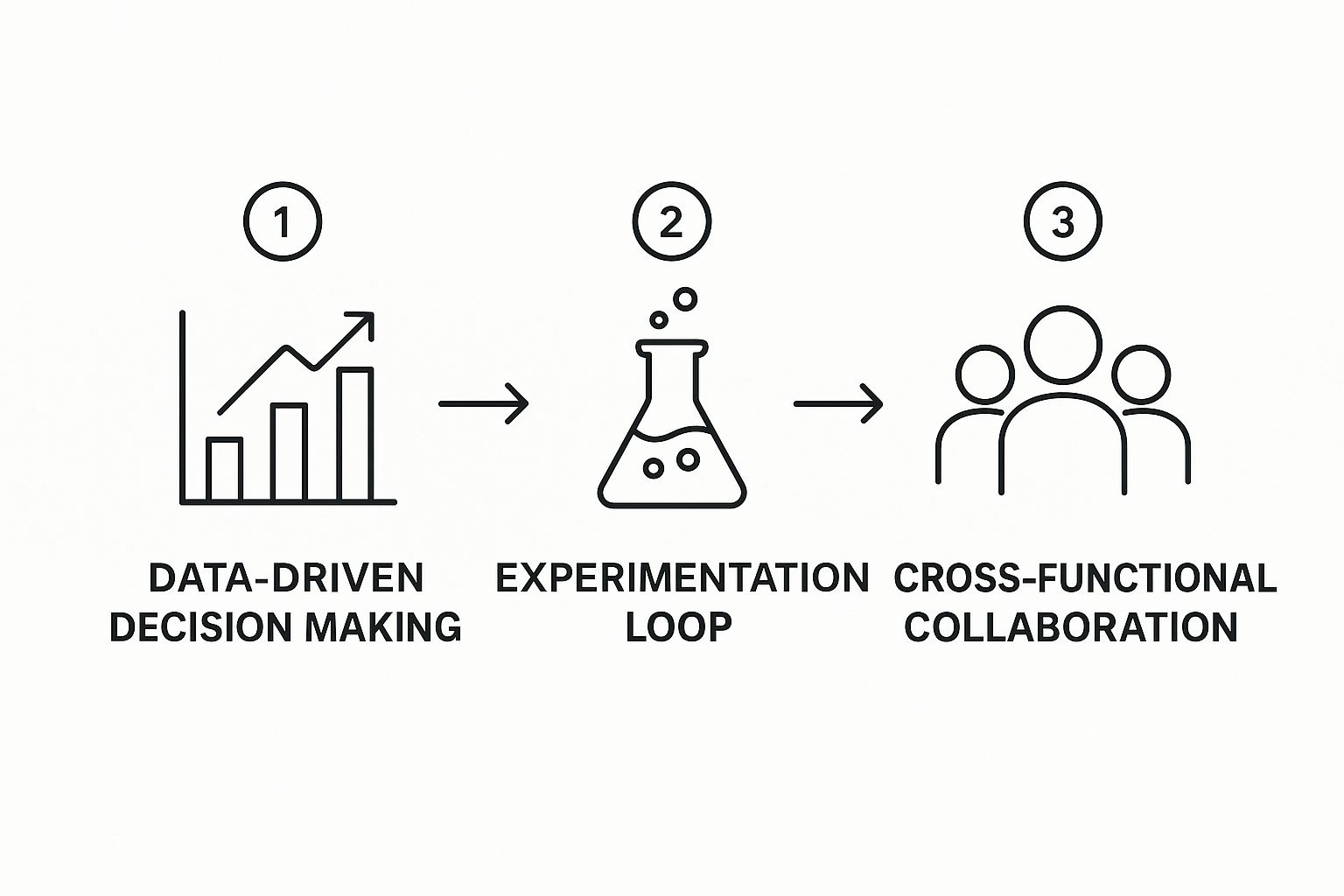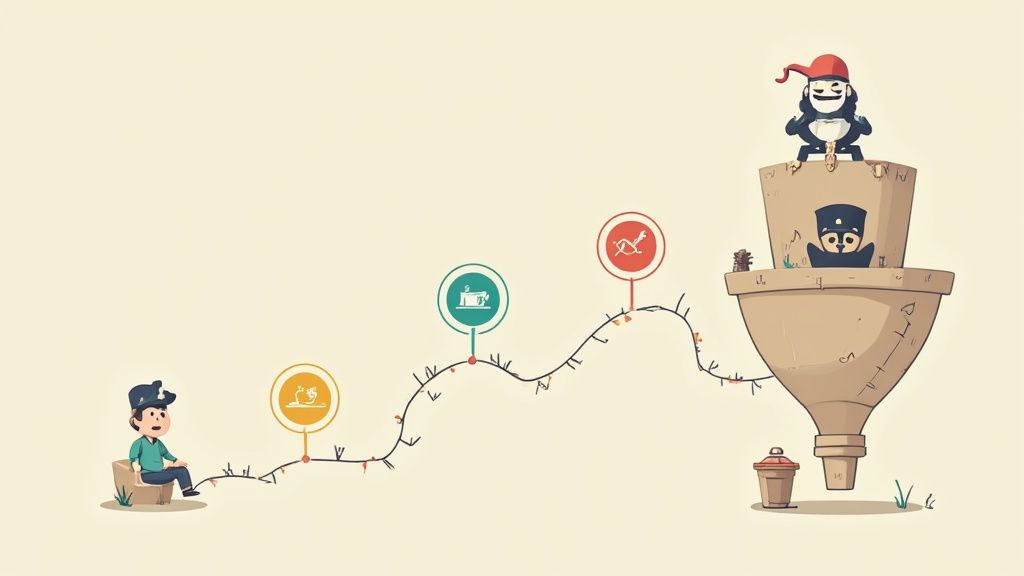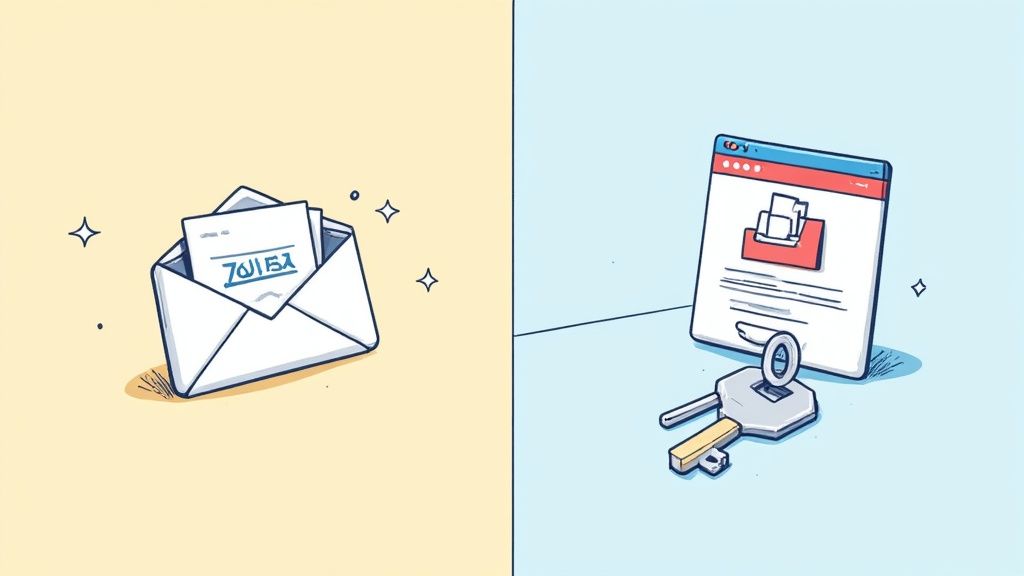What is Growth Hacking? Unlock the Secrets to Rapid Business Growth
Let's be real for a minute. The term "growth hacking" gets thrown around a lot, often sounding like some kind of marketing dark magic. But once you cut through the hype, it’s actually a pretty straightforward concept. So, what is growth hacking?
At its heart, it's less about a specific tactic and more about a relentless, data-obsessed mindset laser-focused on one thing: fast, efficient, scalable growth.
The Core of Growth Hacking

Here’s an analogy I like to use. Think of a traditional marketer as a skilled farmer. They know their land, use proven tools, and aim for a steady, predictable harvest year after year. It works.
A growth hacker, on the other hand, is like a bio-engineer in a high-tech lab. They're constantly running experiments—messing with soil chemistry, splicing genes, and adjusting light cycles—all in the hunt for a breakthrough that makes the plant grow ten times faster.
This mindset blurs the lines between marketing, product, and engineering. The term itself was coined back in 2010 by Sean Ellis, who was looking for a way to describe this new breed of marketer needed by early-stage startups. These companies didn't have massive budgets for traditional ads; they needed to find clever, scalable ways to grow, and fast. You can get more of the backstory over on Built In.
Growth hacking is about figuring out why you grow and then trying to make that happen on purpose, again and again. It’s about a relentless process of experimentation, not just big budgets.
How It Differs from Traditional Marketing
The biggest difference between growth hacking and traditional marketing comes down to scope and speed. Traditional marketing often focuses on the top of the funnel—building brand awareness and getting people in the door. It’s crucial, but it's only part of the story.
A growth hacker is obsessed with the entire customer journey. This is often visualized as the "pirate metrics" framework (AARRR):
- Acquisition: How do we get users in a clever, low-cost way?
- Activation: How fast can we get them to that "aha!" moment where they see the product's value?
- Retention: What makes them stick around for the long haul?
- Referral: How can we get our happy users to bring us more users?
- Revenue: How do we optimize the path to monetization?
To help clarify the distinction, here’s a quick breakdown of how the two approaches stack up against each other.
Traditional Marketing vs Growth Hacking
| Aspect | Traditional Marketing | Growth Hacking |
|---|---|---|
| Primary Goal | Brand awareness, market share, lead generation. | Rapid, scalable user and revenue growth. |
| Process | Campaign-driven, often with long planning cycles. | High-tempo, iterative experimentation (build-measure-learn). |
| Focus | Top-of-funnel (awareness, acquisition). | Full-funnel (acquisition, activation, retention, referral, revenue). |
| Budgeting | Often relies on larger, pre-approved budgets. | Focuses on low-cost, high-impact experiments. |
| Team Structure | Siloed departments (marketing, sales, product). | Cross-functional teams (marketing, engineering, data, product). |
| Metrics | Impressions, reach, leads, cost per acquisition (CPA). | Viral coefficient, lifetime value (LTV), activation rate, churn. |
Ultimately, a growth team isn't going to spend six months planning a single, massive campaign. Instead, they might run 20 small, low-cost experiments in a single month to see what moves the needle. This agile, almost scientific method is the real engine behind growth hacking, making it an incredibly powerful approach for any business trying to scale up without breaking the bank.
Adopting the Growth Hacking Mindset
So, what is growth hacking, really? It’s not just a grab bag of tactics. It's a fundamental shift in how you think about growing a business. This mindset is the engine that drives sustainable growth, turning marketing from a series of one-off campaigns into a repeatable, scientific process.
At its core, this approach is built on a foundation of data, relentless curiosity, and a deep-seated belief in collaboration. It's about ditching the "I think this will work" mentality and embracing a culture of "Let's test this and find out."
Every decision, whether it's tweaking a headline or launching a major feature, is treated as a hypothesis. In this world, being wrong isn’t a failure—it's just a data point that gets you one step closer to what actually works.

As you can see, it all connects. Data fuels your experiments, and collaboration across the entire team amplifies the results. This creates a powerful feedback loop where insights from marketing can inform the product, and engineering insights can spark a new marketing test.
Data Driven Decision Making
The first pillar is an absolute obsession with data. Growth hackers practically live inside analytics dashboards, heatmaps, and customer feedback surveys. Instead of just guessing what users want, they dig into the numbers to uncover the truth of how people actually behave.
For instance, the data might show that 70% of trial users drop off after one specific step in your onboarding flow. Boom. That's not a gut feeling; it's a clear, actionable insight.
This is the starting line for a real experiment. The conversation shifts from "I think we should change the signup button color" to "Data shows a massive drop-off on this page; let's test a simplified form and see if we can lift the activation rate." Of course, to make smart decisions, you first need to know who you're targeting. You can learn more by exploring our guide on how to create buyer personas.
A growth mindset isn't about having all the answers. It’s about knowing how to ask the right questions and trusting the data to guide you to the solution.
The Experimentation Loop
This data-first approach leads directly to the next pillar: a high-tempo cycle of experimentation. Growth teams are constantly running small, controlled tests to validate their ideas. It’s a simple, repeatable loop that keeps the momentum going.
- Hypothesize: Formulate a clear, testable idea based on your data (e.g., "Changing this headline will increase signups by 10%").
- Test: Set up an A/B test or another experiment to measure the actual impact.
- Learn: Dig into the results. Was the hypothesis correct? Why or why not?
- Iterate: Apply what you learned to the next experiment, whether the test was a winner or a loser. Every result is a lesson.
Cross Functional Collaboration
Finally, real growth hacking is a team sport. It completely shatters the old-school silos between marketing, product, engineering, and sales. It has to.
When a marketer, a developer, and a data analyst all huddle together to tackle a growth problem, they bring completely different perspectives to the table. That cross-pollination leads to far more creative and effective solutions than any one department could come up with on its own.
In a true growth culture, growth isn't just the marketing team's job—it's everyone's shared responsibility.
Navigating The AARRR Pirate Funnel
To really get your head around what is growth hacking, you need a map. The most famous one in the startup world is the AARRR Pirate Funnel, a dead-simple framework created by investor Dave McClure. It carves up the messy customer journey into five clear, measurable stages, turning the fuzzy goal of "growth" into a concrete roadmap.
Instead of just spitting out definitions, let's track a user's path through a new productivity app. Thinking about it this way makes the whole framework click—it becomes a practical tool you can actually visualize and use for your own business.

From Stranger To User
The journey always starts with the first two stages. This is all about making a killer first impression.
-
Acquisition: This is just how people find you in the first place. For our app, maybe a user clicks a targeted social media ad, finds us through a blog post on productivity, or just Googles a solution. A growth hacker is constantly tinkering here, testing channels to find the most cost-effective way to get high-quality users in the door.
-
Activation: This is that "aha!" moment where your product's value smacks them in the face. Our new user signs up and is guided through a super-smooth onboarding process that helps them create their first to-do list in under 60 seconds. They get it. They see the value instantly. This stage is make-or-break; a clunky activation experience means they're probably never coming back.
To really nail the AARRR funnel, you have to be relentless about implementing smart conversion rate optimization strategies at every single step. It's not just about getting visitors; it's about turning them into active, hooked users.
From User To Advocate
Once someone is activated, the game shifts from first impressions to building a real, profitable relationship. This is where the last three stages come in, and it's what separates a flash-in-the-pan success from a truly sustainable business.
A classic rookie mistake is dumping 90% of your effort into Acquisition. Real growth hackers know that Retention and Referral are where sustainable companies are built.
These final stages are all about the long game:
-
Retention: Does the user stick around? A week later, our app sends a personalized email highlighting a cool feature they haven't tried. This is a small, targeted experiment designed purely to boost engagement and stop them from churning.
-
Referral: Does the user love it enough to tell their friends? After using the app consistently for two weeks, our user gets a pop-up offering a free month of the premium plan for every friend they invite who signs up. Boom—a powerful viral loop is born.
-
Revenue: Does the user actually pay for it? Finally, our happy, engaged user hits a feature wall and decides to upgrade to a paid plan. Measuring the return on investment for each of these steps is crucial. You can get the full rundown in our guide on how to measure marketing ROI.
Proven Growth Hacking Tactics You Can Use
Knowing the theory is one thing, but putting it into practice is where the real magic happens. Growth hacking tactics aren’t just random ideas you throw at the wall; they’re targeted, data-driven experiments designed to move the needle on a specific metric in the AARRR funnel.
These strategies often blur the lines between product and marketing. They work by creating a natural, self-reinforcing loop where the product itself encourages growth, all while keeping costs incredibly low.
Acquisition And Activation Tactics
Your first hurdle is getting people in the door and proving your product’s value—fast. The tactics here are all about getting discovered and creating an “aha!” moment as quickly and frictionlessly as possible. At its core, growth hacking is about boosting conversions, and you can find some great ideas for improving conversion rates with automation.
Many of these can pump up your user numbers without needing a massive ad budget.
-
Content Upgrades: Don’t just write a blog post and call it a day. Offer something extra valuable—like a downloadable checklist, template, or ebook—in exchange for an email address. This turns casual readers into actual leads. For more inspiration, check out these clever ways to increase website traffic.
-
Freemium Models: Let users experience the core value of your product for free, no strings attached. This smashes the barrier to entry and lets them discover that "aha!" moment on their own terms, making the decision to upgrade to a paid plan feel natural, not forced.
-
A/B Testing Onboarding Flows: Never stop tweaking your signup and onboarding process. You’d be shocked at how much small changes—like cutting one form field or changing the color of a button—can impact the number of new users who stick around.
Key Takeaway: The slickest acquisition hacks feel less like marketing and more like a genuinely helpful product feature. They build trust by delivering real value from the very first click.
Retention And Referral Strategies
Once you’ve got users, the game shifts. Now, it’s all about keeping them hooked and turning them into your biggest fans—people who will shout about your product from the rooftops. This is where you build sustainable, long-term growth.
A single, well-designed viral loop can be more powerful than a million-dollar ad campaign. Just look at Dropbox. They famously offered free extra storage to both the person sending a referral invite and the person signing up. This two-sided incentive turned their entire user base into a volunteer sales force, fueling their explosive growth.
Consider these powerful tactics focused on retention:
- Gamification: Add points, badges, or leaderboards to your product. This taps into our natural desire for achievement and competition, encouraging users to come back and complete key actions.
- Personalized Email Triggers: Set up smart, automated emails based on what users do (or don't do). If someone hasn't logged in for a week, send a friendly nudge highlighting a new feature they might love.
- Viral Loops and Referral Programs: Just like Dropbox, build sharing right into the core product experience. Create a win-win incentive that rewards both the existing user and the new one they bring in, creating a powerful, self-perpetuating growth machine.
Real-World Examples of Growth Hacking Success
Theory is great, but seeing growth hacking in the wild is what really makes the concept click. The most legendary growth stories aren’t about blowing a massive ad budget; they’re tales of clever, low-cost experiments that blew the doors off expectations. These are the stories that show how one unconventional idea can completely change a company's path.
One of the earliest and most brilliant examples came from Hotmail. Instead of buying ads, they did something ridiculously simple. They just added a little signature to the bottom of every email sent from their platform: “P.S. Get your free email at Hotmail.” Just like that, every user became a walking, talking (or emailing) brand ambassador. This created a viral loop that skyrocketed their user base into the millions with almost zero marketing spend.

This kind of thinking—where marketing is baked right into the product itself—is the absolute heart of growth hacking.
Leveraging Other Platforms
Sometimes the fastest way to find your first users is to go where they’re already hanging out. Airbnb did this masterfully in its early days by piggybacking on a platform that was already huge.
They were struggling to get any real traction. Their solution was an ingenious, if a bit cheeky, bit of engineering. They built a bot that let their users cross-post their Airbnb listings to Craigslist with just one click. This instantly put their properties in front of a massive, highly relevant audience already looking for places to stay, giving them a critical foothold without spending a dime on ads.
The most effective growth hacks often feel like a natural extension of the product. They solve a user's problem while simultaneously fueling the company's growth engine.
Modern Growth Hacking Results
This scrappy, creative mindset continues to deliver incredible results today. One consulting firm reported that a retail client saw a 450% jump in monthly revenue and an insane 2700% growth in their direct-to-consumer run-rate by applying these principles. Another banking partner boosted its deposit volumes by 40 million units in a single year using targeted growth strategies. You can see how leading experts are scaling growth on Simon-Kucher.com.
These stories prove that growth hacking isn’t just some fleeting trend. It's a durable, repeatable way to achieve massive scale through a mix of creativity, data, and a relentless focus on what works.
Common Questions About Growth Hacking
As you start digging into growth hacking, you'll find a few questions that always seem to come up. It's a field surrounded by a bit of hype, so let's clear the air and tackle some of the most common misconceptions head-on.
Is Growth Hacking Just a New Name for Marketing?
Not quite. While they definitely swim in the same pool, thinking of them as the same thing misses the core difference in mindset.
Traditional marketing often zeroes in on top-of-funnel goals—things like building brand awareness and capturing leads through established channels. It's about executing well-defined campaigns.
Growth hacking, on the other hand, is obsessed with the entire funnel. It’s a scrappy, data-driven methodology that smashes departmental silos, pulling together product, marketing, and engineering to run rapid experiments at every single stage of the customer journey.
A marketer might ask, "How can we get more traffic to our landing page?" A growth hacker asks, "What quick experiment can we run on our product's onboarding to cut user churn by 5% this week?"
Do I Need to Be a Programmer to Be a Growth Hacker?
No, but you can't be afraid of the technical side of things. You don’t need to be able to code an app from scratch, but having a solid grasp of how products are built and being comfortable with analytics tools is a massive advantage.
Plenty of successful growth hackers come from marketing or product backgrounds. The most critical skills are a relentless curiosity, an analytical brain, and the ability to speak the same language as engineers. Being able to use low-code tools to rig up your own experiments is a huge plus—it means you can test ideas faster without waiting in line for developer resources.
Can Growth Hacking Work for Large Companies?
Absolutely. While growth hacking was born in the lean, fast-moving world of startups, its principles are incredibly powerful for established corporations, too.
Big companies can create dedicated "growth teams" that operate like internal startups. These small, agile teams use data and experimentation to optimize existing products, improve retention, and find new revenue streams. The main hurdle is usually cultural—big organizations often struggle to break free from bureaucracy and embrace a "fail fast" mentality.
But for the companies that get it right, the potential for significant, data-backed growth is immense. It proves this approach scales far beyond its startup roots.
Ready to stop guessing what works? Pages.Report gives you insights from over 368 successful SaaS landing pages so you can build with confidence. See proven patterns and transform your conversions at https://pages.report.
